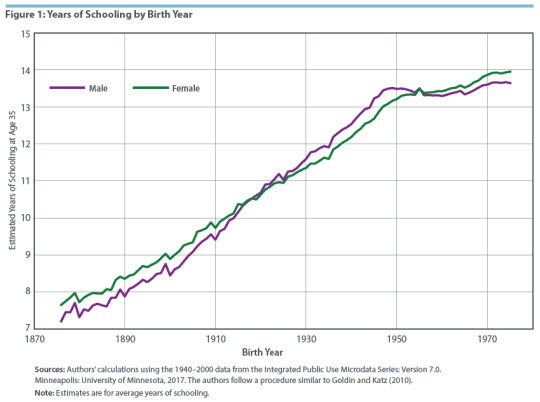Here's a figure showing years of schooling for Americans going dorsum to the 1870s. You tin meet the steady ascension for both men as well as women upwards until the nativity cohorts, when the educational gains for women deadening downwardly as well as those for men become flat.

In their essay, Neelakantan as well as Romero debate that this strengthens the illustration for improving K-12 education, as well as offering some thoughts. Here are a few related points I would emphasize.
1) Lots of factors touching productivity growth for an economy. But rapid United States instruction growth starting dorsum inwards the 19th century has been tied to subsequently United States economical growth. And it's in all probability non only a coincidence that when those born around 1950 were entering the workforce inwards the 1970s, at that topographic point is a sustained slump inwards productivity that lasts close xx years--into the early on 1990s.
2) One argue for the ascension inwards inequality of incomes that started inwards the belatedly 1970s is that the bespeak for high-skilled workers was growing faster than the supply. For example, the wage gap betwixt college-educates worker as well as workers amongst no to a greater extent than than a high schoolhouse instruction increased substantially. As Neelakantan as well as Romero write: "This slowdown inwards science acquisition, combined amongst growing bespeak for high-skill workers, contributed to a large increment inwards the `college premium' — the higher reward as well as net of college graduates relative to workers amongst entirely high schoolhouse degrees." When educational attainment went flat, it likewise helped to practise the weather condition for United States inequality to rise.
3) When a gild has a catamenia of a couplet of decades where educational attainment doesn't rise, there's no fashion to become dorsum subsequently as well as "fix" it. The consequences similar slower growth as well as higher inequality only march on through time. Similarly, the electrical current generation of students--all of them, K-12, college as well as university--will live the side past times side generation of United States workers. Sumber http://conversableeconomist.blogspot.com/

Comments